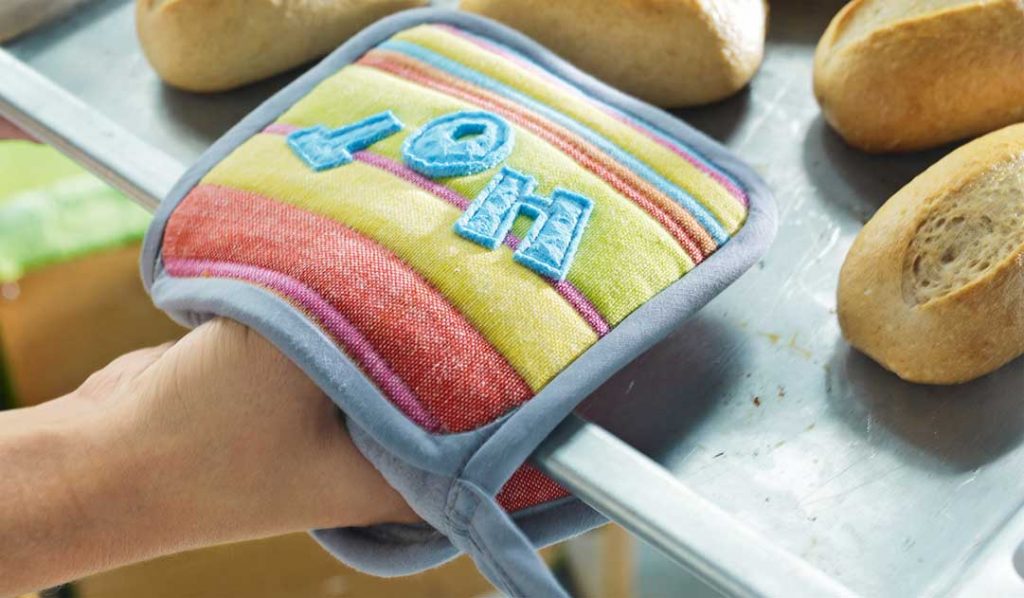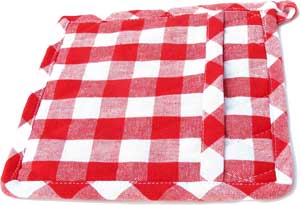Whether you call them hot pads or potholders, the purpose is the same—to protect hands and table surfaces from the heat of a pan just removed from the stove or oven.
Hot pads are an ideal beginner sewing project (perfect for kids), and they’re a fun way to use up scraps since they don’t take much fabric. Because of their size, they’re also ideal to experiment with new sewing techniques you may want to try out before using on a larger project.
Hot pads are so much fun, we bet you can’t make just one!

Size-wise
Hot pads can be made in many sizes and shapes, but one thing’s for certain, whatever shape you choose, be sure they’re large enough to keep your hands from getting burned when in use.
Many potholders are simple squares—from 5” to 10”, though the larger sizes offer better protection. Some are circular and of similar sizes, while others are rectangular and designed to be folded over a warm pot handle. There are also patterns for holiday themed shapes, like Easter eggs, Valentine hearts or Christmas trees.
In addition to their padded selves, most potholders offer an extended loop for hanging. The loop can be made of the same fabric as the holder or from the binding used around the shape’s edge. Loops can be along one side, or at a corner.
Layer Up
The anatomy of a potholder is simple—two layers of fabric with heat-resistant protective layers between. It’s important that the outer fabric layers are not synthetic, as they should be able to withstand heat up to 400° Fahrenheit. Cotton is a good choice for the outer layers as it’s heat resistant and readily washable.
Between the outer layers is the main source of heat protection. Some sewers like to use multiple layers of preshrunk wool for its insulative qualities, others use layers of cotton batting, and perhaps most effective is a batting with an insulative layer, like Insul-Bright®, made by the Warm Company or Pellon Insul-Fleece™. (Product links lead to Amazon and any purchases you make may make us a small commission at no additional cost to you). This specialized product has a metallicized polyester film needle-punched into batting. This heat-protective layer should then be sandwiched between two layers of cotton batting.
Artful Additions
Because of their small size, potholders are the perfect canvas to try a new sewing technique like appliqué, machine embroidery or decorative stitching (with cotton threads), strip piecing, scrappy piecing, etc.
Simply draw the shape of your potholder onto the right side of one fabric layer, do your embellishing and trim the piece to size. If you’re piecing the potholder front and/or back, do that sewing before cutting the shapes.
Back to Basics
To make a hot pad, layer the back and front pieces wrong sides together with your choice of the inside insulative layer(s). Pin the layers and quilt them together. Quilting can be done in straight lines, free-motion designs, or using an embroidery machine. If you choose not to quilt the layers together, baste around the perimeter about 1/8” from the cut edges.
Cut a 2 ¼”-wide strip of binding fabric to go around the potholder. Depending on the size, it may be necessary to piece together two width-of-fabric strips. Note: If your potholder has curved corners, cut the binding on the bias. Fold the binding in half wrong sides together and press.
 Bind the potholder, mitering the binding at any corners. When you come back to the starting point, stop just before the original stitching, but do not trim of the extra binding length.
Bind the potholder, mitering the binding at any corners. When you come back to the starting point, stop just before the original stitching, but do not trim of the extra binding length.
Turn the binding to the underside and hand- or machine-stitch the folded edge in place. At the original start point, fold the binding and extend it to form a hanging loop and stitch the edges together, tucking the raw end under the end of the binding portion. Finish the stitching to anchor the loop base.
Once you’ve mastered the basics of potholder making, consider adding a pocket to one side. Slide your hand inside for easier gripping with the padded portion of the hot pad.
~Linda Griepentrog
Linda is the owner of G Wiz Creative Services and she does writing, editing and designing for companies in the sewing, crafting and quilting industries. In addition, she escorts fabric shopping tours to Hong Kong. She lives at the Oregon Coast with her husband Keith, and two dogs, Yohnuh and Abby. Contact her at .






